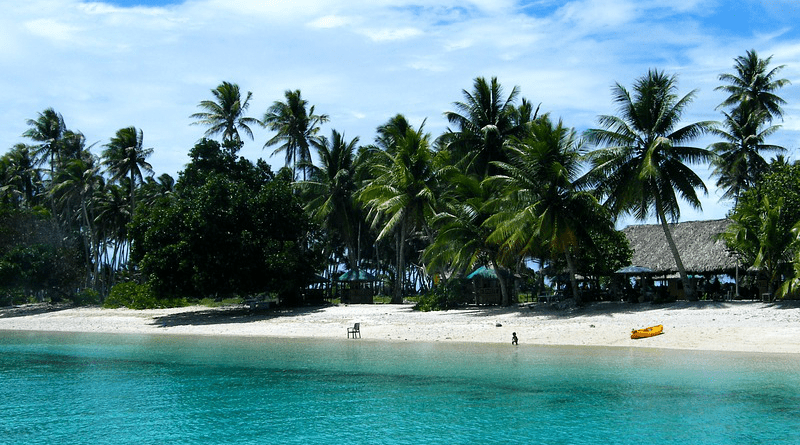Learning From Climate Impacts On Health And Migrations In Marshall Islands
Back in 1989, when the world was just starting to become aware of global warming, then-President of the Marshall Islands Amata Kabua delivered alarming remarks at the opening of the first Intergovernmental Meeting on Climatic Change and Sea Level Rise in the South Pacific, held in the Marshalls’ capitol, Majuro. “We who live on coral atolls would be in the deepest trouble,” he foretold, if emerging data on the warming climate proved true. “The results will be erosion, flooding by salt water of our food crops, intrusion of salt water into the freshwater aquifer—all of which would become so ruinous that we would have to abandon our atolls to seek resettlement where land is dry and our people are welcomed.”
His words were prescient. Today, residents of Pacific islands are already living with overt impacts of climate change, including sea-level rise, ocean acidification and extreme weather events. These disasters on their own can cause people to move away, but they also affect overall public health, which can become a less-visible driver in residents’ decisions whether to stay or go.
Climate impacts ‘shape mobility’
In a recent East-West Center AsiaPacific Issues paper, A Changing Climate and Its Implications for Health and Migration in the Pacific: Examples from the Marshall Islands, authors Laura Brewington, Kelli Kokame and Nancy Lewis use the current situation—and response—in the Marshalls to consider potential Pacific-wide strategies for the future.
Not only does climate change directly and indirectly impact health itself, they write, but its impacts “also shape mobility, which in turn has consequences for health. In the Pacific Islands, public health [is] already negatively affected by changes in temperature, rainfall, extreme events, sea level rise, and ocean acidification.”
These changes have wide-ranging health consequences. Ocean acidification affects the availability of reef fish, which can increase reliance on imported and processed foods. Drought and rising temperatures limit the availability of fresh drinking water, while, on the other end of the spectrum, heavier than normal rainfalls increase the potential for diseases transmitted by contaminated floodwater, mosquitoes, ticks, and fleas. And medical facilities can themselves be impacted by storm damage.
It is not always possible to draw a clear line between the health impacts of climate change and migration, since the decision to migrate is often driven by a multitude of factors. But Brewington et al note that climate change in general is predicted to increase migration, and that those who have already left their islands cite the changing conditions as one reason they may never return.
Health care access a migration driver
Several studies have shown the varied impacts that climate change is having in the Marshalls. One recent survey, for example, found that more than 90 percent of Marshallese respondents had been affected by droughts; nearly half had been affected by heat waves; and close to 40 percent had been impacted by exceptionally high king tides.
Meanwhile, a lack of access to adequate health care has itself become a driver of out-migration. “Out of 199 Marshallese households surveyed in a recent study, 49 percent identified poor health care as one of the top five most pressing problems on their home island,” the authors note. “Furthermore, respondents who reported experiencing negative health impacts due to events such as drought, king tides, and heat waves were significantly more likely to migrate internally, as well as internationally.”
Internally, they write, the urban population in the Marshall Islands increased from 35,000 to 41,500 between 2000 and 2010, with overcrowding causing yet another strain on public health. Meanwhile, the number of Marshallese living in the United States nearly tripled during the same 10-year period, from 6,700 to 22,400.
Forward-thinking steps
While climate change poses an immediate threat to the Pacific, the situation is not completely hopeless, the paper’s authors report. In the Marshalls, a variety of steps are being taken that may ultimately allow citizens to remain in place, and to see migration as a choice rather than the sole option.
As the links between climate change, migration and public health come into sharper focus, so too has the need to involve health professionals in the planning process. The authors point to a network of agencies and community groups that will ultimately create more robust planning and responses in the Marshalls, while also citing the recently released National Adaptation Plan (NAP) as a forward-thinking development.
“The NAP is working across multiple sectors (health, emergency response, education, housing, infrastructure, ecosystems management, etc.) to reduce vulnerability to the impacts of climate change and facilitate the integration of climate change adaptation into national policy,” they write. “Ensuring habitability of the islands and atolls—through the protection of livelihoods, culture, physical well-being, and mental health—is central to the purpose.”

